Pretty good, from space. Benjamin Grant, who runs the Daily Overview feed, has put together a "greatest hits" collection in book form, which will be available October 25th:
The best images appear inOverview: A New Perspective of Earth. The book reveals the many ways humans shape the world. Groves of bright green olive trees stand ready for harvest. Deep blue and purple caverns cut into the earth at a uranium mine. Iron tailings turn a pond bright pink. Grant uses juxtaposition to underscore the point, placing, say, a deforested rain forest alongside a paper mill. “You’re able to make comparisons within the chapters, in a way that you can’t if it’s one image per day on the Instagram feed,” he says. The last chapter celebrates remote places, like the reptilian ridges of Rub’ al Khali, the world’s largest contiguous sand desert.
Many of the images are aesthetically beautiful in the abstract, but troubling in context: the aligned grids on a rust-red landscape of the Dadaab Refugee Camp in Kenya, or the yellow stripe and black ridges of a coal shipping terminal in Qinhuangdao, China. Grant hopes to show that tension. “You have an overwhelming sense of the time that would be required to create these staggering landscapes—erosion, build up of mountains—compared to what we’ve developed in the past 100 years,” says Grant.
I pre-ordered the book as soon as Grant posted he was publishing it.
I took the unusual step of driving to work this morning, and regret it profoundly:

The problem was that Google Maps said to turn from Lake Shore Drive onto Jackson. Unfortunately, Jackson and Balbo are closed because of Sunday's Marathon. So from the river down to Roosevelt, the Drive was a parking lot. (That bit took about 25 minutes.) With Roosevelt no help, I drove down to I-55 and then up State, and from there it was a quick half-hour to go the remaining 24 blocks to the office. Keep in mind, I've walked the equivalent of home to work in under 90 minutes.
Can my day get better?
Rolling Stone describes how Wrigleyville became Douchebag Central:
Chicagoans have strong feelings about Wrigleyville. While a local might have more nuanced thoughts on neighborhoods like Logan Square (gentrified, filled with hipsters, great places to eat) or Wicker Park (gentrified, filled with yuppies, great places to eat), say you're going to hang out near Wrigley Field, and you'll probably get a blank stare. You really go out of your way to visit there for two reasons: Cubs games and shows at the Metro, the area's long-running venue that has played host to everybody from Metallica in 1983 to Nirvana in 1989 and nearly every important Chicago band or artist from Ministry at the dawn of the city's burgeoning industrial music scene to Chance the Rapper in 2016. Joe Shanahan, who opened the venue in 1982, remembers a time when he needed to be escorted by security to his car after a late-night. Not so much because of the fans, but because it was a neighborhood in a big city in the 1980s. "It was scary," he says of his early days turning the former Swedish Community Center built in 1927. "But it was inexpensive."
But things change.
You know the story: people living on the fringe make the area seem attractive to people with money, the people with money move in and, soon to follow are the bars with 20 televisions all showing sports. Wrigleyville, already a strange neighborhood because of its cozy little ballpark and the cursed team that plays there, somehow seemed like a decent fit for a bunch of outcasts. It was normal to end up at the McDonald's across the street from the ballpark and see kids from whatever show let out ordering Big Macs alongside sloshed baseball fans. It was awkward, but both groups were strange in their own way: kids with the funky hairstyles and clothes, and the baseball fans that would cheer for a team that they know will only disappoint.
I'm not sure it's the most insightful view of how Wrigleyville has changed, but it's somewhat accurate.
The Chicago Tribune reports that the annoying trend of using smaller airplanes for longer routes is taking off over the Atlantic:
The re-engined 737 Max and A320neo jets offer a 15 percent fuel saving meant to cut costs on the shortest inter-city services. At the same time the revamp has added about 800 km to their range -- just enough to allow the narrow-bodies to span the 5,000 km between the eastern U.S. and Western Europe.
Norwegian Air Shuttle, JetBlue Airways and Portugal's TAP are among airlines buying the jets for trans-Atlantic routes, with NAS set to lead the way when it becomes one of the first carriers to get Boeing's Max 8 next year. Its initial flights may link Edinburgh, Birmingham in England and Cork and Shannon in Ireland to smaller airports in New England and the New York area.
Yeah, 8 hours in a 737 or A320 does not sound fun. The only exception I'd make is for BA flights 1, 2, 3, and 4, which are 32-seat, all-business-class A319s that fly between London City and JFK. Of course, they're not exactly marketing to price-conscious leisure travelers: a round trip on that route will set you back about $6,000. And one more thing: the return trip tops up its fuel tanks in Shannon, Ireland, because even a stripped-down A319 can't make it all the way from London to New York yet.
At work, I typically sit at an east-facing window on the 35th floor of the Sears Willis Tower. Here's my view:

That means I can often see Michigan, Indiana, and everything in between, including very large boats out on the Lake. For the last half-hour I've watched a huge white thing slowly steam South, wondering what it was. It turns out, there's a website for that. And the boat is, in fact, pretty big:

So the 138-meter Glostrander is puttering southward at 19 km/h towards South Chicago. Good to know. (You can see the boat in the photo above just to the left of the Board of Trade building. It's the white horizontal sliver close to the horizon.)
The Economist has found that craft breweries are inversely correlated with religiosity in the US:
Some states are craftier than others. Atop the list of craft breweries per capita is Vermont, with 44 of them crammed into one of the nation’s smallest and least populated states. In addition to being better liquored, Vermonters are a good bit more godless than the national average. This reflects a broader trend: there is a markedly negative correlation between a state’s religiosity and breweries per person.
Local regulations determine the level of production much more than demographic characteristics such as income or education, says Bart Watson, chief economist of the Brewers Association, a craft-beer trade organisation. And religious legislators may get a bit overzealous. Utah, a state populated with many teetotaling Mormons, strictly limits the strength of draught beers and cocktails.
As you'd expect from that newspaper, they have a cool chart, too.
Usually I just link to articles I haven't read yet. This morning, here's a list of videos friends have posted. (They take longer than articles.)
And, OK, one article: Politico interviewed dozens of people who were involved with getting the president home on 9/11, fifteen years ago today. Their accounts are riveting.
Workers digging London's Crossrail tunnel have helped uncover a 350-year-old mystery about the Great Plague:
[T]he Great Plague...killed 100,000 Londoners (roughly a quarter of the city’s population) around 350 years ago.
Last year, workers constructing a future new ticket hall at Liverpool Street Station unearthed a charnel pit adjoining the old Bedlam Hospital, in which 3,000 skeletons were interred. Now it turns out that some of these skeletons had the answer to a centuries’ old mystery, hidden away in their teeth.
Scientists at Germany's Max Planck Institute took samples from the teeth of 20 of these corpses, and this week confirmed what historians have long suspected but been unable to prove: London's Great Plague was caused by the Yersinia Pestis bacteria, exactly the same pestilence that killed around one-third of Europe's population in the 14th century, under the name the Black Death.
The BBC has more.
I've been meaning to post this photo from July. No story behind it; I just think it's cool.

It's fascinating how working from home doesn't seem to give me more time to, you know, work. So these have backed up on me, and I hope to read them...someday:
OK, so, that's going to take a few minutes...